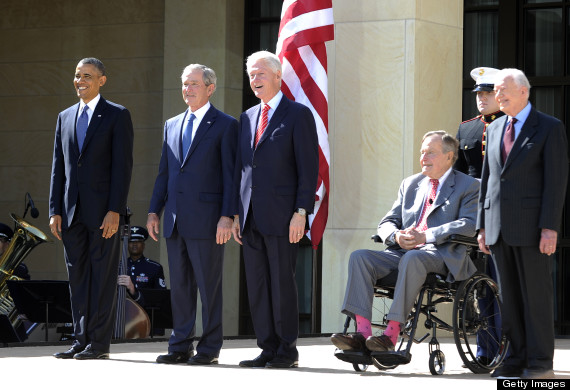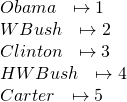Grab some collection of objects and count it. How does that work?
Let's say we want to count the (living) former Presidents of the United States in this photograph:

We're so good at counting that we'd probably just glance and say "5". But if we were three or four years old, we'd probably have to count more carefully, which means doing something like placing our index finger on Obama and pronouncing "one", shifting the index finger to W. Bush and pronouncing "two", shifting the index finger to Clinton and pronouncing "three", shifting it to H. W. Bush and pronouncing "four", and finally shifting to Carter and pronouncing "five".
In other words, we would construct the following explicit bijection:

Definition. We call the set A finite if either A is empty, or there is some ![]() and a bijection
and a bijection ![]() . The number
. The number ![]() is called the cardinality of A. The cardinality of the empty set is defined to be 0.
is called the cardinality of A. The cardinality of the empty set is defined to be 0.
We've been dealing with finite sets our whole lives, and much of set theory is inspired by them. We'll take the time to record some important facts, which may seem obvious but are worth noting.
Theorem. If ![]() is finite and there is a surjection
is finite and there is a surjection ![]() , then
, then ![]() is finite.
is finite.
Proof. We'll start with a lemma:
Lemma. If there is a surjection ![]() , then there is an injection
, then there is an injection ![]() .
.
Proof. Since ![]() is a surjection, for each
is a surjection, for each ![]() , there is some
, there is some ![]() with
with ![]() . Pick one of them and call it
. Pick one of them and call it ![]() .
.
We claim ![]() is an injection.
is an injection. ![]() .
.
So now we have an injection ![]() from
from ![]() to a finite set. Further, there is some bijection
to a finite set. Further, there is some bijection ![]() . Then
. Then ![]() is an injection. But every function is a surjection onto its range, so
is an injection. But every function is a surjection onto its range, so ![]() is bijective with a subset of
is bijective with a subset of ![]() , hence must be finite.
, hence must be finite. ![]()
Corollary. If ![]() is finite and there is an injection
is finite and there is an injection ![]() , then
, then ![]() is finite.
is finite.
Corollary. Any subset of a finite set is finite.
Proof. If ![]() and
and ![]() is finite, consider the function
is finite, consider the function ![]() given by
given by ![]() . This is an injection, so the previous corollary applies.
. This is an injection, so the previous corollary applies.![]() .
.
Definition. We call ![]() a proper subset of
a proper subset of ![]() if
if ![]() but
but ![]() ; that is, if every element of
; that is, if every element of ![]() is an element of
is an element of ![]() , but there is some element of
, but there is some element of ![]() which is not an element of
which is not an element of ![]() .
.
Theorem. If ![]() is finite, then
is finite, then ![]() is not equivalent to any of its proper subsets.
is not equivalent to any of its proper subsets.
Proof. Suppose not. Then there is some finite set ![]() and a proper subset
and a proper subset ![]() of
of ![]() with
with ![]() . So there is some
. So there is some ![]() with
with ![]() .
.
Now let ![]() be the bijection which shows that
be the bijection which shows that ![]() is finite, and arrange so that
is finite, and arrange so that ![]() . Then the range of
. Then the range of ![]() is a subset of
is a subset of ![]() . But then
. But then ![]() would be equivalent to a subset of
would be equivalent to a subset of ![]() , which is absurd.
, which is absurd. ![]() .
.
Perhaps the most surprising part of this theorem is that we have the assumption ``![]() is finite". You might think that there's no way a set could be equivalent to the set you get after you remove an element. But! Infinite sets are kind of weird; or at least we aren't used to dealing with them so our intuitions are sometimes wrong.
is finite". You might think that there's no way a set could be equivalent to the set you get after you remove an element. But! Infinite sets are kind of weird; or at least we aren't used to dealing with them so our intuitions are sometimes wrong.
Definition. We call a set ![]() infinite if it is not finite.
infinite if it is not finite.
Theorem. If ![]() is equivalent to one of its proper subsets, then
is equivalent to one of its proper subsets, then ![]() is infinite.
is infinite.
Proof. This is the contrapositive of the last theorem.
This theorem (though you might think its hypothesis never applies) turns out to be a very useful way to prove that a particular set is infinite.
Theorem. ![]() is infinite.
is infinite.
Proof. Consider the function ![]() . This is a function from
. This is a function from ![]() to
to ![]() . Notice that there is a function
. Notice that there is a function ![]() given by
given by ![]() , which has
, which has
![]()
so that ![]() serves as an inverse to
serves as an inverse to ![]() . Therefore
. Therefore ![]() is a bijection, and so
is a bijection, and so ![]() .
. ![]()
We can also give another proof, which is how most proofs that something is infinite go. Since infinite just means not finite, we challenge the reader to try and tell us how many elements the infinite set has. Then we show we can always defeat them, by finding an element they left out of their count.
Another proof that ![]() is infinite.
is infinite.
Suppose ![]() had finitely many elements, say
had finitely many elements, say ![]() of them. Then there would be a bijection
of them. Then there would be a bijection ![]() .
.
Let ![]() . Then
. Then ![]() is strictly greater than any of the
is strictly greater than any of the ![]() . Therefore
. Therefore ![]() . so
. so ![]() is not onto. This contradiction establishes the theorem.
is not onto. This contradiction establishes the theorem. ![]() .
.
The following proof of this type is the oldest recorded reductio ad absurdum.
Theorem. (Euclid, ca. 300 BCE) There are infinitely many prime numbers.
Proof. Suppose there were finitely many prime numbers, say ![]() of them. List them all:
of them. List them all: ![]() . Consider the numbers
. Consider the numbers
![]()
Now we know that ![]() has at least one prime factor; call that factor
has at least one prime factor; call that factor ![]() . Observe that
. Observe that ![]() could not be 2, because
could not be 2, because ![]() is even, so
is even, so ![]() is odd. Further,
is odd. Further, ![]() could not be 3, because
could not be 3, because ![]() is a multiple of 3, so
is a multiple of 3, so ![]() has remainder 1 when we divide by 3. Proceeding in this way, we find that
has remainder 1 when we divide by 3. Proceeding in this way, we find that ![]() cannot be any of the prime numbers we listed.
cannot be any of the prime numbers we listed.
So we have found a prime that was not on our list, which we supposed to be complete. This contradiction establishes the theorem.![]() .
.
We can also show that a set is infinite by finding an infinite subset:
Theorem. If ![]() and
and ![]() is infinite, then
is infinite, then ![]() is infinite.
is infinite.
Proof. Assume ![]() . We will show that if
. We will show that if ![]() is infinite, then
is infinite, then ![]() is infinite. The contrapositive of this claim is: If
is infinite. The contrapositive of this claim is: If ![]() is finite, then
is finite, then ![]() is finite, which we already showed.
is finite, which we already showed.![]()
E.g. ![]() is infinite.
is infinite.
Actually this can be souped up:
Theorem. If ![]() is infinite and there is an injection
is infinite and there is an injection ![]() , then
, then ![]() is infinite.
is infinite.
E.g. ![]() is infinite.
is infinite.
Proof. Consider the function ![]() given by
given by ![]() .
.
If ![]() , then
, then ![]() , so
, so ![]() . This shows that
. This shows that ![]() is an injection, so the above theorem shows that
is an injection, so the above theorem shows that ![]() is infinite.
is infinite. ![]()
![]() is in fact the smallest infinite set, in the following sense:
is in fact the smallest infinite set, in the following sense:
Theorem. Any infinite set has a subset which is equivalent to ![]() .
.
Proof. Let ![]() be an infinite set. We'll show, by induction, that we can pick a distinct element
be an infinite set. We'll show, by induction, that we can pick a distinct element ![]() for each
for each ![]() .
.
For the base case, pick ![]() . Note that
. Note that ![]() is not empty (otherwise
is not empty (otherwise ![]() would have had only one element to begin with).
would have had only one element to begin with).
For the inductive step, suppose we've picked ![]() distinct elements of
distinct elements of ![]() already. Then
already. Then ![]() is not empty (otherwise
is not empty (otherwise ![]() would have only
would have only ![]() elements), so there is some
elements), so there is some ![]() which is distinct from
which is distinct from ![]() .
.
Mathematical induction allows us to continue this way to define ![]() for any
for any ![]() , thus building a bijection
, thus building a bijection ![]() .
. ![]() .
.
